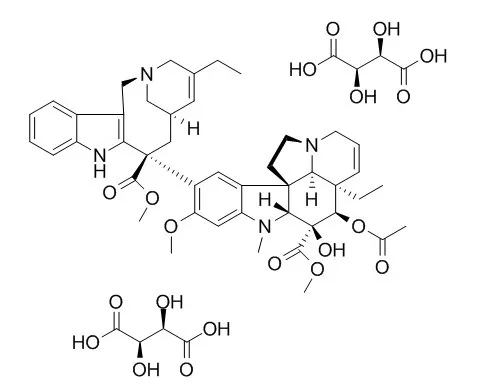| In vitro: |
| Am J Hosp Pharm. 1994 Feb 15;51(4):495-9. | | Visual, turbidimetric, and particle-content assessment of compatibility of vinorelbine tartrate with selected drugs during simulated Y-site injection.[Pubmed: 8017415] | The compatibility of Vinorelbine Tartrate with selected drugs during simulated Y-site administration was studied.
METHODS AND RESULTS:
A 5-mL sample of Vinorelbine Tartrate 1 mg/mL in 0.9% sodium chloride injection was combined with a 5-mL sample of each of 91 other drugs at concentrations used clinically. Each combination was prepared in duplicate, with the order of mixing being reversed between the two; storage was in constant fluorescent light at 22 degrees C. The admixtures were examined visually in normal fluorescent light and with a Tyndall beam at zero, one, and four hours after preparation. A turbidimeter was used to measure the turbidity of each drug combination at the same intervals. Samples showing visual or turbidimetric evidence of incompatibility were subjected to particle counting and sizing. The majority of the drugs tested were compatible with Vinorelbine Tartrate; most combinations had a turbidity of less than 0.1 nephelometric turbidity unit. Turbidity measurements showed that cefazolin sodium, ceforanide, and cefuroxime sodium were incompatible with Vinorelbine Tartrate.
Visual observation showed incompatibility of Vinorelbine Tartrate with acyclovir sodium, aminophylline, amphotericin B, ampicillin sodium, cefoperazone sodium, ceforanide, cefotetan sodium, ceftriaxone sodium, fluorouracil, furosemide, ganciclovir sodium, methylprednisolone sodium succinate, mitomycin, piperacillin sodium, sodium bicarbonate, thiotepa, and trimethoprimsulfamethoxazole.
CONCLUSIONS:
Vinorelbine Tartrate 1 mg/mL in 0.9% sodium chloride injection was compatible with the majority of the drugs tested for up to four hours at 22 degrees C but was incompatible with 19 drugs. |
|
| In vivo: |
| Pharmacotherapy: The Journal of Human Pharmacology and Drug Therapy Volume 19, Issue 8, pages 992–994, August 1999 | | Vinorelbine Tartrate-Induced Pulmonary Edema Confirmed on Rechallenge[Reference: WebLink] | | A 67-year-old woman with metastatic breast cancer experienced sudden and profound pulmonary edema within 45 minutes after completion of intravenous administration of Vinorelbine Tartrate on two occasions. Both times the drug was discontinued and the patient was treated aggressively with oxygen, intravenous furosemide, and a vasodilator. The patient suffered no lasting medical complications due to the reaction. Until clear documentation and the mechanism for occurrence of this reaction are known, patients receiving vinorelbine should be monitored closely, particularly in the first few hours after intravenous administration. | | 《Journal of Ningxia Medical University》 2010-07 | | The Protection Effects of Matrine on Vinorelbine Tartrate Induced Venous Injury[Reference: WebLink] | To explore the protection effect of the Matrine on antitumor drug-Vinorelbine Tartrate Injection induced venous injury.
METHODS AND RESULTS:
The auricular venous injury model of rabbits was established by intravenous infusion of VTI.Different methods were selected to treat the injury: applying Matrine and applying MgSO4.The injury status of the veins and peripheral tissues were observed and HE stain were performed after 48 hours and 7 days treatment,respectively.the histopathological features of the veins and peripheral tissues were analyzed. After comparing the histopathological results of the samples among the 3 groups,the venous injury of the Matraine group was the least severe one in aspect of Lumen hyperemia,inflammatory cell infiltration,bleeding of the perivascular for past 48 hours treatment(P0.05);for post 7days treatment,the venous injury of the Matraine group was the least severe one in aspect of inflammatory cell infiltration,bleedingof the perivascular(P0.05);the subsidence of the venous injury of the Matraine group was the earliest one(P=0.000).
CONCLUSIONS:
Matrine is an effective method on prevention of the antitumor drug Vinorelbine Tartrate induced venous injury. |
|






 Cell. 2018 Jan 11;172(1-2):249-261.e12. doi: 10.1016/j.cell.2017.12.019.IF=36.216(2019)
Cell. 2018 Jan 11;172(1-2):249-261.e12. doi: 10.1016/j.cell.2017.12.019.IF=36.216(2019) Cell Metab. 2020 Mar 3;31(3):534-548.e5. doi: 10.1016/j.cmet.2020.01.002.IF=22.415(2019)
Cell Metab. 2020 Mar 3;31(3):534-548.e5. doi: 10.1016/j.cmet.2020.01.002.IF=22.415(2019) Mol Cell. 2017 Nov 16;68(4):673-685.e6. doi: 10.1016/j.molcel.2017.10.022.IF=14.548(2019)
Mol Cell. 2017 Nov 16;68(4):673-685.e6. doi: 10.1016/j.molcel.2017.10.022.IF=14.548(2019)